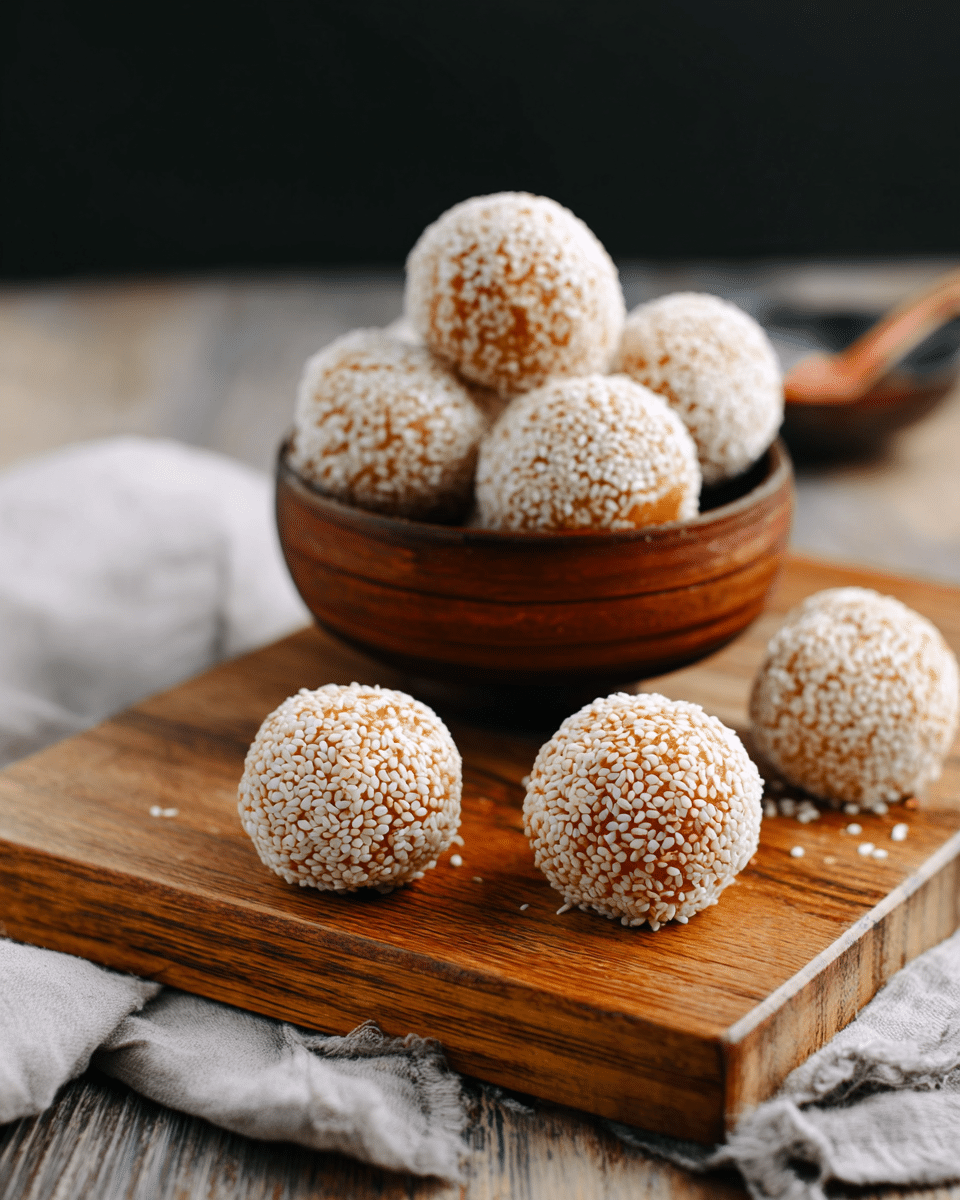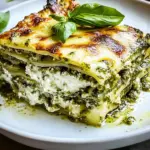Sesame balls are a beloved Chinese dessert with a crispy golden exterior and a warm, sweet filling. The delightful contrast of textures between the crunchy sesame coating and the soft interior is simply irresistible. These deep-fried treats are commonly enjoyed during celebrations, festivals, and family gatherings, making them a favorite comfort food.
The versatility of sesame balls makes them an excellent choice for experimenting with different fillings, like sweet red bean paste, lotus seed paste, or even chocolate! Regardless of the filling, these sesame balls promise to deliver a deliciously satisfying treat perfect for any occasion.
Full recipe:
Ingredients:
-
1 ½ cups glutinous rice flour
-
1/2 cup all-purpose flour
-
1/4 teaspoon salt
-
1 tablespoon sugar
-
2 tablespoons vegetable oil
-
1/2 cup warm water
-
1/2 cup red bean paste or lotus seed paste
-
1/2 cup sesame seeds
-
Vegetable oil for frying
Directions:
-
In a large bowl, combine the glutinous rice flour, all-purpose flour, salt, and sugar. Mix well.
-
Gradually add the vegetable oil and warm water to the flour mixture, stirring until a dough forms.
-
Divide the dough into small balls (about 1 ½ inches in diameter).
-
Flatten each dough ball and place a spoonful of red bean or lotus seed paste in the center.
-
Carefully seal the dough around the filling, rolling it back into a ball shape.
-
Roll each ball in sesame seeds until fully coated.
-
Heat vegetable oil in a deep fryer or large pot to 350°F (175°C).
-
Fry the sesame balls in batches for 3-4 minutes, or until golden brown and crispy on the outside.
-
Remove from oil and drain on paper towels. Serve hot.
Prep Time: 15 minutes | Cooking Time: 15 minutes | Total Time: 30 minutes Kcal: 160 kcal per ball | Servings: 12 sesame balls
History of Sesame Balls
The origins of sesame balls can be traced back to the Tang Dynasty (618–907 AD) in China, although some sources suggest they may have been enjoyed even earlier. Historically, sesame balls were not just a treat for the rich and noble but were accessible to everyday people. The simple ingredients—flour, sesame, and sweet fillings—made them an affordable yet delicious dessert that could be enjoyed by many. Over the centuries, they became a staple of Chinese street food culture and are now widely available in bakeries and markets across China and other parts of Asia.
The dish is often served during Chinese festivals like the Mid-Autumn Festival and Lunar New Year, as well as in Buddhist temples for offerings, symbolizing good luck and prosperity. The round shape of the sesame ball is symbolic of unity and completeness, which makes them a fitting treat for celebrations and family gatherings.
Cultural Significance of Sesame Balls
In Chinese culture, food is more than just nourishment; it plays a significant role in symbolizing prosperity, luck, and harmony. Sesame balls, with their golden, crispy exterior and sweet interior, are considered a symbol of happiness and good fortune. The round shape represents wholeness and togetherness, making sesame balls an ideal treat for family reunions and special occasions.
During the Chinese New Year, it is common to enjoy sesame balls as part of the traditional dessert spread, alongside other symbolic foods like dumplings and Nian Gao (sticky rice cake). The act of sharing these treats with friends and family is thought to bring luck and good fortune for the year ahead. They are also popular during the Mid-Autumn Festival, when people gather to celebrate the harvest and the moon.
Variations of Sesame Balls
While traditional sesame balls are made with sweet red bean paste or lotus seed paste, the versatility of the recipe allows for numerous variations. In some regions, you might find sesame balls filled with black sesame paste, which offers a nuttier, richer flavor. Others may include coconut or peanut filling, giving the sesame ball a unique twist while maintaining its crispy texture.
In addition to the fillings, the dough itself can vary. Some recipes use glutinous rice flour, which gives the balls a chewy, almost doughy texture, while others may use a combination of rice flour and all-purpose flour for a slightly different consistency. The sesame seeds that coat the outside can also be varied, with some recipes using toasted white sesame seeds, while others opt for black sesame seeds to create a striking contrast in appearance.
Health Aspects of Sesame Balls
Sesame balls are undeniably delicious, but like most fried treats, they are best enjoyed in moderation. The deep-frying process gives them their signature crispy texture, but it also increases their calorie content, making them a more indulgent snack. The sesame seeds themselves are packed with healthy fats, fiber, and antioxidants, providing a nutritional boost. Sesame seeds are known to have heart-healthy benefits due to their high content of unsaturated fats, particularly omega-6 fatty acids.
However, the fillings in sesame balls, such as red bean paste, are often sweetened with sugar, which can increase the sugar content of the treat. For those who are health-conscious or watching their sugar intake, it’s possible to modify the recipe by using less sugar or opting for alternative fillings like mashed sweet potato or fruit pastes.
Sesame balls can also be a source of plant-based protein, especially when made with high-quality sesame seeds. If you’re looking to make them even healthier, you could experiment with air-frying or baking them instead of deep-frying, reducing the oil content while still achieving a crispy texture.
Making Sesame Balls at Home
Making sesame balls at home can be a fun and rewarding experience. While the process may seem a bit intricate at first, it’s relatively straightforward once you understand the steps. The dough is simple to prepare, and the filling options are endless. Whether you prefer the classic red bean paste or want to try something more adventurous, like chocolate or peanut butter, you can customize the filling to suit your taste.
The key to making perfect sesame balls is ensuring that the dough is the right consistency. It should be firm enough to hold its shape when you roll it into balls, but not so dry that it cracks. The oil should also be heated to the right temperature (about 350°F or 175°C) to ensure that the balls fry evenly and achieve that perfect golden color.
For those who have never fried sesame balls before, it’s important to monitor the oil temperature closely. If the oil is too hot, the outside will burn before the inside has had a chance to cook properly. If the oil is too cool, the sesame balls will absorb too much oil, resulting in a greasy texture.
Serving and Enjoying Sesame Balls
Sesame balls are best enjoyed fresh, right out of the fryer when they are still hot and crispy. They can be served as a standalone dessert or alongside other traditional Chinese treats, such as mooncakes or tangyuan (sweet rice balls). Because of their small size, sesame balls are often served as finger food, making them perfect for parties, potlucks, or as a fun snack for a casual gathering.
They can also be enjoyed with a cup of tea, particularly jasmine tea or oolong tea, which complement the sweet and savory flavors of the sesame balls. The contrast between the warm, crispy exterior and the soft, sweet interior makes each bite a delightful experience.
Conclusion
Sesame balls are more than just a delicious dessert; they are a cultural staple that brings people together. Whether enjoyed during a festival, a family gathering, or as a simple snack, these golden, crispy treats hold deep cultural significance. Their versatility allows for endless variations, making them a timeless favorite in Chinese cuisine. While they may be indulgent, their unique texture, rich flavor, and symbolism of good fortune make sesame balls a treat worth savoring.
With their crispy coating, chewy texture, and sweet filling, sesame balls are a perfect example of how food can carry both flavor and meaning. Whether you’re making them at home for a special occasion or simply enjoying them as a snack, sesame balls are sure to bring a smile to your face and warmth to your heart.






